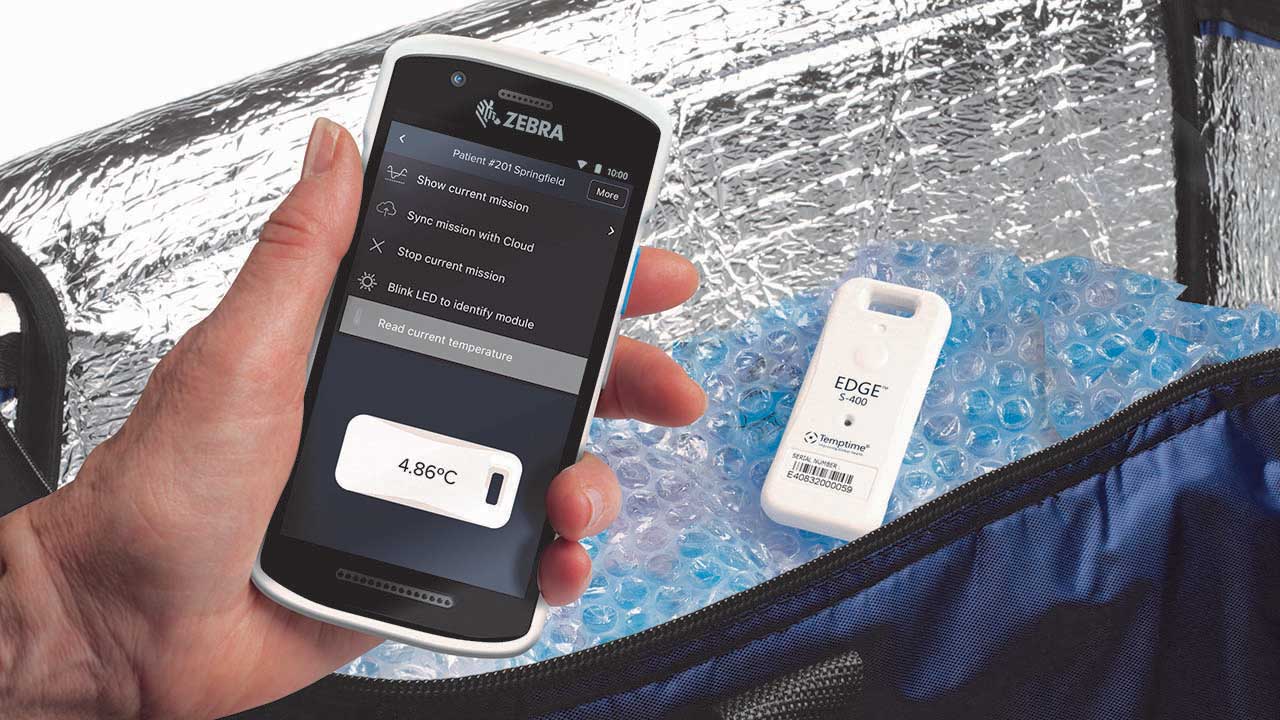Transform retail operations with Zebra’s retail technology solutions, featuring hardware and software for improving inventory management and empowering teams.
Streamline operations with Zebra’s healthcare technology solutions, featuring hardware and software to improve staff collaboration and optimise workflows.
Enhance processes with Zebra’s manufacturing technology solutions, featuring hardware and software for automation, data analysis, and factory connectivity.
Zebra’s transportation and logistics technology solutions feature hardware and software for enhancing route planning, visibility, and automating processes.
Zebra's hospitality technology solutions equip your hotel and restaurant staff to deliver superior customer and guest service through inventory tracking and more.
Zebra's market-leading solutions and products improve customer satisfaction with a lower cost per interaction by keeping service representatives connected with colleagues, customers, management and the tools they use to satisfy customers across the supply chain.
Empower your field workers with purpose-driven mobile technology solutions to help them capture and share critical data in any environment.
Zebra's range of mobile computers equip your workforce with the devices they need from handhelds and tablets to wearables and vehicle-mounted computers.
Zebra's desktop, mobile, industrial, and portable printers for barcode labels, receipts, RFID tags and cards give you smarter ways to track and manage assets.
Zebra's 1D and 2D corded and cordless barcode scanners anticipate any scanning challenge in a variety of environments, whether retail, healthcare, T&L or manufacturing.
Zebra's extensive range of RAIN RFID readers, antennas, and printers give you consistent and accurate tracking.
Choose Zebra's reliable barcode, RFID and card supplies carefully selected to ensure high performance, print quality, durability and readability.
Zebra's location technologies provide real-time tracking for your organisation to better manage and optimise your critical assets and create more efficient workflows.
Zebra's rugged tablets and 2-in-1 laptops are thin and lightweight, yet rugged to work wherever you do on familiar and easy-to-use Windows or Android OS.
With Zebra's family of fixed industrial scanners and machine vision technologies, you can tailor your solutions to your environment and applications.
Zebra’s line of kiosks can meet any self-service or digital signage need, from checking prices and stock on an in-aisle store kiosk to fully-featured kiosks that can be deployed on the wall, counter, desktop or floor in a retail store, hotel, airport check-in gate, physician’s office, local government office and more.
Discover Zebra’s range of accessories from chargers, communication cables to cases to help you customise your mobile device for optimal efficiency.
Zebra's environmental sensors monitor temperature-sensitive products, offering data insights on environmental conditions across industry applications.
Enhance frontline operations with Zebra’s AI software solutions, which optimize workflows, streamline processes, and simplify tasks for improved business outcomes.
Zebra Workcloud, enterprise software solutions boost efficiency, cut costs, improve inventory management, simplify communication and optimize resources.
Keep labour costs low, your talent happy and your organisation compliant. Create an agile operation that can navigate unexpected schedule changes and customer demand to drive sales, satisfy customers and improve your bottom line.
Drive successful enterprise collaboration with prioritized task notifications and improved communication capabilities for easier team collaboration.
Get full visibility of your inventory and automatically pinpoint leaks across all channels.
Reduce uncertainty when you anticipate market volatility. Predict, plan and stay agile to align inventory with shifting demand.
Drive down costs while driving up employee, security, and network performance with software designed to enhance Zebra's wireless infrastructure and mobile solutions.
Explore Zebra’s printer software to integrate, manage and monitor printers easily, maximising IT resources and minimising down time.
Make the most of every stage of your scanning journey from deployment to optimization. Zebra's barcode scanner software lets you keep devices current and adapt them to your business needs for a stronger ROI across the full lifecycle.
RFID development, demonstration and production software and utilities help you build and manage your RFID deployments more efficiently.
RFID development, demonstration and production software and utilities help you build and manage your RFID deployments more efficiently.
Zebra DNA is the industry’s broadest suite of enterprise software that delivers an ideal experience for all during the entire lifetime of every Zebra device.
Advance your digital transformation and execute your strategic plans with the help of the right location and tracking technology.
The Zebra Aurora suite of machine vision software enables users to solve their track-and-trace, vision inspection and industrial automation needs.
Zebra Aurora Focus brings a new level of simplicity to controlling enterprise-wide manufacturing and logistics automation solutions. With this powerful interface, it’s easy to set up, deploy and run Zebra’s Fixed Industrial Scanners and Machine Vision Smart Cameras, eliminating the need for different tools and reducing training and deployment time.
Aurora Imaging Library™, formerly Matrox Imaging Library, machine-vision software development kit (SDK) has a deep collection of tools for image capture, processing, analysis, annotation, display, and archiving. Code-level customisation starts here.
Aurora Design Assistant™, formerly Matrox Design Assistant, integrated development environment (IDE) is a flowchart-based platform for building machine vision applications, with templates to speed up development and bring solutions online quicker.
Designed for experienced programmers proficient in vision applications, Aurora Vision Library provides the same sophisticated functionality as our Aurora Vision Studio software but presented in programming language.
Aurora Vision Studio, an image processing software for machine & computer vision engineers, allows quick creation, integration & monitoring of powerful OEM vision applications.
Adding innovative tech is critical to your success, but it can be complex and disruptive. Professional Services help you accelerate adoption, and maximise productivity without affecting your workflows, business processes and finances.
Zebra's Managed Service delivers worry-free device management to ensure ultimate uptime for your Zebra Mobile Computers and Printers via dedicated experts.
Find ways you can contact Zebra Technologies’ Support, including Email and Chat, ask a technical question or initiate a Repair Request.
Zebra's Circular Economy Program helps you manage today’s challenges and plan for tomorrow with smart solutions that are good for your budget and the environment.

What the Shift to Patient-Centric Healthcare Means for Home Infusion Pharmacies
The global healthcare system has been on a path of transformation for several years – due in part to an aging population but pushed forward in many ways because of COVID-19.
The United Nations predicts that by 2025 the world's population will increase by one billion – nearly a third of whom will be 65 or older as life expectancy rises. Access to “middle class comforts” and urbanization is also increasing, which can lead to more sedentary lifestyles and chronic illnesses. There is concern this will all put pressure on the global health system to manage and pay for care. That's one of the reasons we've seen a move toward a more patient-centric, community-based approach to healthcare.
As my colleague and Zebra Chief Nursing Informatics Officer, Rikki Jennings, pointed out in a recent conversation I had with her and our colleague Katie Kraverath, "Baby boomers – which make up a large portion of the healthcare workforce today – are continuing to age. Without more aggressive recruitment and training to replace them, there will not be enough healthcare workers to care for patients.” Plus, the healthcare systems in nations such as the U.S. are so driven by regulations that increased guidelines supporting community-based healthcare – including home infusion therapies – are likely to follow.
That’s why Rikki and Katie both believe home-based healthcare is the best way to reach more people in a way that is potentially not as labor-intensive – and I agree.
Katie has been working with specialty pharmacies for several years and has seen how the regulatory environment has evolved. “Over the years, as the field of specialty medication grew, so did regulations around it – particularly on medication storage and distribution,” she noted in our sit down. That's why today, many state boards of pharmacy and accreditation agencies require some type of medication temperature monitoring for inventory onsite and in transit.
“To earn URAC accreditation, for instance, specialty pharmacies must monitor temperature in all environments where medication is stored,” she says. “That includes refrigerators and freezers as well as ambient or controlled room temperature storage where they also need to monitor humidity.”
How COVID-19 Advanced Home-Based Healthcare
In the early days of the pandemic, the Center for Disease Control and Prevention (CDC) began recommending that U.S. healthcare providers start seeing patients virtually as much as possible. Temporary emergency easing of federal and state regulations combined with new health insurance payment policies also made it easier for patients and doctors to connect virtually. What followed was a 154% increase in telehealth visits during the last week of March 2020 compared to the same time the year before.
While most of these visits were likely related to COVID-19, the fact is the last year has driven about 20 years of innovation, says Rikki. “The pandemic accelerated the transition in the care that was already underway.” (This is also something Rikki discussed with Zebra’s Healthcare Customer Advisory Board in 2020 and detailed further in this blog post.)
An Increase in Home-Infusion Therapy
The pandemic touched other areas of the healthcare system as well, especially where a telehealth visit was not enough and home-based care was critical – including the delivery of home infusion therapy. In upstate New York, one provider was in the middle of a pilot study focused on the safety and effectiveness of home infusion for anti-tumor necrosis factor therapies for pediatric patients when the lockdown went into effect. Once the pandemic sent people home, more and more families asked to join the study. They quickly discovered advantages of home infusion for their children – no lost time from school or work since there was no need for travel, and infusions could be scheduled at times convenient to the families. This upswing in requests for home infusion therapies was seen nationwide as healthcare providers began looking for ways to transition patients from the hospital to in-home care to comply with stay-at-home orders and reserve hospital beds for patients very sick with COVID-19.
As a result, like telehealth, the growth in demand for and adoption of home infusion therapy is expected to continue.
What Does this Mean for Home Infusion Providers?
While many home infusion medications are stable at room temperature, excessive heat, cold or humidity exposures can still impact their effectiveness. That's why home infusion pharmacies seeking accreditation from an organization approved by the Centers for Medicare & Medicaid Services (CMS) may need to consider temperature monitoring. The Joint Commission, for example, follows the U.S. Pharmacopeia (USP) temperature guidelines for storing compound sterile preparations, which some home infusion providers may be handling. Many agencies, including URAC and the Joint Commission, also require their members to test the performance of packaging used to ship or transport medication – something specialty pharmacies have been doing for several years.
Based on what she's seen within the specialty pharmacy field, Katie believes that as the need for home infusion continues to grow, the regulatory environment will shift and become more stringent as well.
If you want to learn more about how temperature monitoring solutions are designed to work specifically for home infusion providers, this infographic is a great place to start. If you have specific questions, please get in touch with Katie directly. She’s a fantastic resource!
###
Related Reads:

Shannon Swanson
Shannon Swanson is Manager, Product Management, Healthcare Supplies Portfolio at Zebra Technologies.
Zebra Developer Blog
Zebra Developer Blog
Are you a Zebra Developer? Find more technical discussions on our Developer Portal blog.
Zebra Story Hub
Zebra Story Hub
Looking for more expert insights? Visit the Zebra Story Hub for more interviews, news, and industry trend analysis.
Search the Blog
Search the Blog
Use the below link to search all of our blog posts.
Most Recent
Legal Terms of Use Privacy Policy Supply Chain Transparency
ZEBRA and the stylized Zebra head are trademarks of Zebra Technologies Corp., registered in many jurisdictions worldwide. All other trademarks are the property of their respective owners. ©2025 Zebra Technologies Corp. and/or its affiliates.






